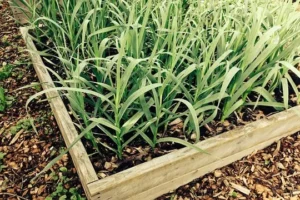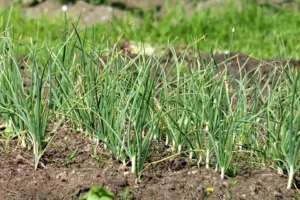When it comes to cultivating garlic, many people envision large fields with rows of garlic plants basking in the sun. However, with the advent of greenhouse technology, it is now possible to grow garlic in a controlled environment, providing optimal conditions for its growth. In this comprehensive guide, we will explore the process of growing garlic in a greenhouse, from selecting the right variety to harvesting the flavorful bulbs. Whether you are an experienced gardener or a novice enthusiast, this guide will equip you with the knowledge and skills necessary to embark on a successful garlic cultivation journey.
Benefits of growing garlic in a greenhouse
Growing garlic in a greenhouse offers numerous advantages over traditional outdoor cultivation. Firstly, a greenhouse provides a controlled environment, allowing you to regulate temperature, humidity, and light levels. This control ensures that your garlic plants receive consistent conditions throughout their growth cycle, resulting in healthier and more vigorous plants. Additionally, a greenhouse protects your garlic crop from adverse weather conditions, such as heavy rains or frost, which can damage the bulbs and hinder their growth. By creating an ideal microclimate, you can extend the growing season and even cultivate garlic during the winter months.

Understanding different garlic varieties
Before diving into the details of greenhouse cultivation, it is essential to familiarize yourself with the various garlic varieties available. Garlic can be broadly categorized into two types:
1.hardneck and 2.softneck.
Hardneck garlic varieties, as the name suggests, have a stiff central stalk, or neck, and produce fewer cloves but larger bulbs. They are known for their robust flavor and are often preferred by culinary enthusiasts. On the other hand, softneck garlic varieties have a more pliable neck and tend to produce more cloves per bulb. They have a milder flavor and are commonly used for braiding and storage.
There are numerous cultivars within each type, each with its own unique characteristics. Some popular hardneck varieties include Rocambole, Porcelain, and Purple Stripe, while softneck varieties like Artichoke and Silverskin are widely grown. Garlic cultivars should be chosen for greenhouse growth after taking into account characteristics including flavor preferences, storage capacity, and regional adaptability.
Choosing the right location for your greenhouse
The success of your garlic greenhouse largely depends on choosing the right location. The greenhouse should ideally be located in a location that receives plenty of sunshine throughout the day. Garlic plants thrive in full sun, so a location that offers at least six hours of direct sunlight is ideal. Additionally, ensure that the greenhouse is not obstructed by tall trees or buildings that could cast shadows and reduce sunlight exposure.
Another critical factor to consider is the orientation of the greenhouse. In regions with hot summers, orienting the greenhouse east to west will minimize the intensity of the sun during the peak hours, preventing excessive heat buildup. Conversely, in cooler regions, orienting the greenhouse north to south will maximize sunlight exposure. Proper ventilation is also crucial to prevent excessive humidity and maintain optimal air circulation within the greenhouse.
Preparing the soil for garlic cultivation
Preparing the soil is a crucial step in ensuring successful garlic cultivation. Garlic grows best on well-drained soil with a pH between 6 and 7.5. Begin by removing any weeds or debris from the greenhouse bed. This can be done by hand or through mechanical means, such as tilling. Once the bed is clear, amend the soil with organic matter, such as compost or well-rotted manure, to improve its structure and fertility.
To ensure optimal drainage, consider incorporating perlite or vermiculite into the soil. These additives help prevent waterlogging, which can lead to root rot and other diseases. Additionally, adding a balanced slow-release fertilizer will provide essential nutrients for the garlic plants throughout their growth cycle. Before planting, it is recommended to conduct a soil test to determine the nutrient levels and make any necessary adjustments.
Planting garlic cloves in a greenhouse
Now that the soil is prepared, it’s time to plant the garlic cloves in your greenhouse. To begin, choose healthy garlic bulbs with large cloves. Carefully separate the cloves from the bulb, ensuring that each clove is intact and free from any signs of disease or damage. It is crucial to use quality cloves, as they will directly influence the size and quality of the resulting bulbs.
Create furrows in the greenhouse bed, spacing them approximately 6 inches apart. The furrows should be around 2 inches deep. Place each garlic clove in the furrow, ensuring that the pointed end faces upwards. Space the cloves approximately 4 to 6 inches apart within the furrow. Once all the cloves are planted, cover them with soil, gently firming it around the cloves.
Providing the ideal growing conditions for garlic
To ensure optimal growth and development, garlic plants require specific environmental conditions within a greenhouse. Firstly, maintain a temperature range between 50°F and 75°F (10°C to 24°C) during the day, and slightly cooler temperatures at night. Garlic is a cold-hardy plant, but excessive heat can inhibit bulb formation. Ventilation and shading may be necessary during hot summer days to prevent the greenhouse from overheating.

Garlic also requires consistent humidity levels to thrive. Aim for a relative humidity range of 50% to 70% to prevent the bulbs from drying out or becoming too moist. Regularly monitor the humidity levels within the greenhouse and make adjustments as needed. Using a humidifier or misting system can help achieve the desired humidity levels.
Lastly, garlic plants require sufficient light to fuel their growth. While garlic can tolerate partial shade, it thrives in full sun conditions. Ensure that the greenhouse receives ample sunlight throughout the day, or supplement with artificial grow lights if necessary. Maintain a photoperiod of 14 to 16 hours of light per day to promote vigorous growth and bulb formation.
Watering and fertilizing garlic plants
Proper watering and fertilization are essential for maximizing the yield and quality of your garlic bulbs. Garlic plants prefer consistently moist soil, but overwatering can lead to rot and disease. Water the plants whenever the top inch of soil feels dry, aiming for approximately 1 inch of water per week. Use a drip irrigation system or a soaker hose to deliver water directly to the root zone, minimizing moisture on the foliage.
Garlic plants have certain nutrient needs during their growth cycle in terms of fertilization. Add a balanced slow-release fertilizer to the soil before planting. As the plants develop, this will give a consistent flow of nutrients. Additionally, during the first three weeks of growth, side-dress the garlic plants with nitrogen-rich fertilizer. This will encourage ferocious foliage growth.
Dealing with common pests and diseases in garlic cultivation
While growing garlic in a greenhouse minimizes the risk of pests and diseases, it is still important to remain vigilant and take preventive measures. Some common pests that can affect garlic include aphids, thrips, and nematodes. Regularly inspect your plants for any signs of infestation, such as distorted leaves, discoloration, or stunted growth. If pests are detected, consider using natural remedies like neem oil or insecticidal soaps to control their population.
Garlic is generally resistant to many diseases, but certain fungal infections can still occur. White rot, pink root, and rust are some common diseases that can affect garlic. To prevent these diseases, ensure proper crop rotation, as planting garlic in the same location year after year can increase the risk of infection. Additionally, avoid excessive moisture on the foliage by watering at the base of the plants. If fungal infections are detected, consider using organic fungicides or sulfur-based sprays to control the spread.
Harvesting and curing garlic in a greenhouse
The moment of harvesting is one of the most rewarding experiences for any gardener. Garlic is typically ready for harvest when the lower leaves begin to turn yellow and dry out. This usually occurs after 6 to 8 months of planting, depending on the variety and growing conditions. Carefully loosen the soil around the bulbs using a garden fork or trowel, being cautious not to damage the bulbs.
Once the bulbs are dug up, gently brush off any excess soil and trim the roots to approximately half an inch. It is crucial to handle the bulbs with care to prevent bruising or damage. Next, it’s time to cure the garlic bulbs, a process that allows them to dry sufficiently for long-term storage. Hang the bulbs in a well-ventilated area, away from direct sunlight, for a period of 2 to 3 weeks. This will allow the outer layers of the bulbs to dry and form a protective skin.

After the curing period, trim the dried stems and roots, leaving approximately an inch above the bulb. Cure garlic bulbs should be kept in a cool, dry environment with excellent air movement. Properly cured garlic can last for several months, providing you with a steady supply of flavorful bulbs until the next growing season.
Tips for successful garlic cultivation in specific regions – Ohio and Virginia
While the cultivation of garlic in a greenhouse follows similar principles regardless of the location, there are specific considerations for certain regions. Let’s explore some tips for successful garlic cultivation in Ohio and Virginia.
Growing garlic in Ohio
Ohio experiences cold winters, making it essential to protect garlic plants from freezing temperatures. Insulate your greenhouse by using thermal blankets or bubble wrap to prevent heat loss during the coldest months. Consider using a supplemental heat source, such as a heater or heating mats, to maintain a consistent temperature range within the greenhouse. Additionally, choose cold-hardy garlic varieties like Rocambole or Porcelain, which are better suited to withstand the harsh winter conditions in Ohio.
Growing garlic in Virginia
Virginia offers a milder climate compared to Ohio, but it still experiences cold winters. To ensure successful garlic cultivation in Virginia, select garlic varieties that is adapted to the region, such as Silverskin or Artichoke. To give the plants time to establish their root systems before the winter sets in, plant garlic cloves in the fall, around the middle of October. Apply a layer of mulch around the plants to insulate the soil and protect the bulbs from freezing temperatures. Regularly monitor the moisture levels in the greenhouse and adjust watering accordingly.
Exploring the history and origins of garlic
Garlic has a long and illustrious history extending back thousands of years. Native to Central Asia, garlic was cultivated by ancient civilizations such as the Egyptians, Greeks, and Romans. It was highly prized for its medicinal properties and was even used as currency in certain regions. Garlic made its way to different parts of the world through trade routes, eventually becoming a staple in various cuisines. Today, garlic is grown and enjoyed worldwide, adding flavor and aroma to countless dishes.
Final thoughts:
Growing garlic in a greenhouse is a rewarding endeavor that allows you to enjoy a bountiful harvest of flavorful bulbs. By following the steps outlined in this guide, you can create the ideal conditions for your garlic plants to thrive. From selecting the right variety to providing optimal growing conditions and addressing potential challenges, this guide has equipped you with the knowledge and skills necessary for successful garlic cultivation. Now, it’s time to roll up your sleeves, don your gardening gloves, and embark on your garlic greenhouse journey. Happy growing!